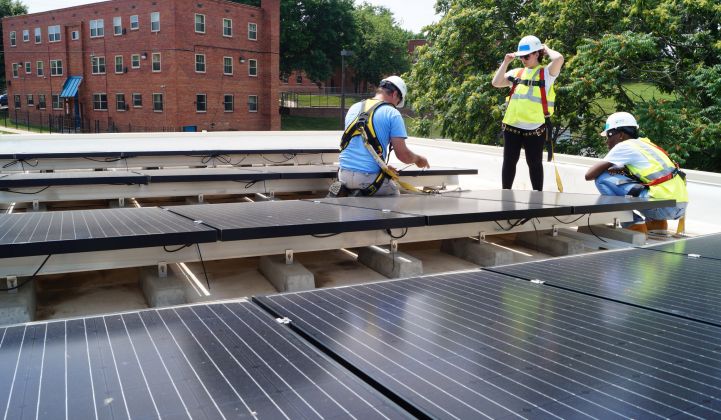They say diversity is the spice of life. And yet television shows, universities, the tech industry and others continue to struggle with how to fairly represent women and minority groups -- and the renewable energy industry is no exception.
According to the International Renewable Energy Agency, global renewable energy employment (not including large-scale hydropower) reached 8.3 million in 2016. Solar energy jobs totaled 3.7 million last year, up 15 percent over 2015, and wind energy jobs totaled 1.2 million, up 7 percent over 2015.
Despite this growth, women and ethnic minority groups still face challenges in breaking through the renewable energy employment glass ceiling -- although industry leaders are attempting to resolve this problem. And why shouldn't the sustainable energy sector lead on diversity?
Today, female representation within the renewable energy sector is small. In OECD nations, it’s estimated that only 20 percent of those employed are women. A majority work in sales and administration, followed by engineering and technical departments. Solar PV is the largest renewables sector representing female workers, followed by solar heating and cooling, wind energy, biomass and biofuel.
In the U.S. solar industry specifically, women make up 28 percent of the workforce, and relatively few hold leadership positions. Minority groups are also underrepresented in the cleantech workforce.
Only 6.6 percent of solar workers in 2016 were African-American, according to The Solar Foundation. For comparison, African-Americans make up 13.3 percent of the U.S. population, according to the 2016 census. Latinos and Asian-Americans fare much better, at 17.2 percent and 9.1 percent working in the U.S. solar industry, respectively. Census data finds these minority groups make up 17.8 and 5.7 percent of the U.S. population, respectively.
Solar isn’t the only industry relevant to the renewables sector, however. In the U.S. wind industry, 8 percent of employees are African-American and 32 percent are women, which is below the national workforce averages, according to the Department of Energy.
An Ernst & Young survey found that women represented only 5 percent of board executives and 16 percent of board members across the global power and utilities sector in 2015. Over three years, the number of women on boards has only increased by 1 percent.
These low employment figures for women and minorities are also visible in environmental organizations.
A 2014 University of Michigan report found that males made up 70 percent of boards and chairs of environmental groups. White females were also more likely to be promoted to boards, compared to minority men and women. Just 12 percent of environmental organizations have ethnic minorities in leadership positions, while only 4 percent are on boards.
The report condemns environmental groups for not seeking to create diverse workplaces. Traditional economic sectors, including business, finance and even sports have done better.
But alliances have been forming to support a cultural shift within the renewable energy workforce.
Kristen Graf of Women of Wind Energy told Greentech Media that the future of the wind industry may hinge on increased workplace diversity. Graf said that having more women employed in the wind power workforce can bring new and unique perspectives to the business, including in finance and engineering. To start looking beyond wind, the group rebranded itself as Women of Renewable Industries and Sustainable Energy (WRISE) earlier this year. Graf still serves as executive director.
WRISE has been instrumental in raising awareness and supporting the need for further training of women within the industry. The American Wind Energy Association supports educational and training opportunities for women, using scholarships to entice more females into wind power.
Solar companies have also tried to address the concerns of a lack of ethnic diversity in the industry. SolarCity has gone out to various job fairs targeting minority groups to increase its talent base.
This increased engagement has helped to further diversity among women and racial groups in renewable energy. In the U.S. wind and solar sectors, workforce representation is on the rise. This slow shift is aligned with the current demographic change happening in the U.S. population, which in turn should be positive for business.
As many groups are teaming up to improve workplace diversity within the cleantech sector, small gains are also occurring within environmental organizations. In 2015, Aaron Mair became the first African-American elected as Sierra Club president. Mair helped in many campaigns, including one supported by the Sierra Club to clean up the Hudson River. It eventually led to a settlement between General Electric and the Environmental Protection Agency to clean up toxic sediments in the Upper Hudson River.
However, more work needs to be done as women and minority groups strive to develop a diversified labor pool, including more education, collaboration and awareness.
Grist recently suggested that in a period where the U.S. federal government is cutting back on environmental protection, more connections need to be made between grassroots activities (many of them led by women or people of color) and big environmental groups. The article points to a study from the organization Green 2.0, which surveyed top environmental non-governmental organizations. The study suggested that nearly 75 percent employed are white, while 15 percent are people of color. Green 2.0 also said only 40 percent of organizations have a diversity plan ready.
Van Jones, author of The Green Collar Economy, put it best. “To change our laws and culture, the green movement must attract and include the majority of all people, not just the majority of affluent people.” That includes renewable energy companies and advocates.
***
Susy Bento is the marketing and communications manager at Alcen Renewable. Alcen Renewable is a utility-scale developer based in sunny California.



